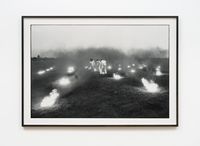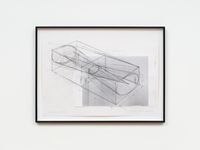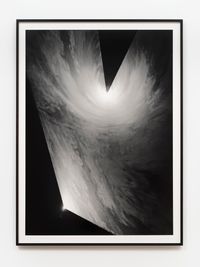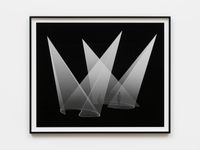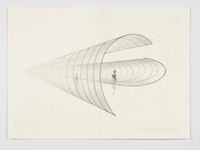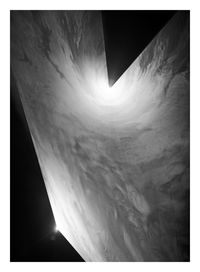British artist Anthony McCall's practice is characterised by a keenness towards expanding the definition of cinema. He is known as a pioneer of film and installation experimentation. His artworks cross through film, sculpture, installation, drawing and performance, and become all five at once.
Read MorePart of the 1970s London Film-makers Co-operative, McCall began making experimental films in London in 1971. His early films recorded outdoor performances. Landscape for Fire (1972), for example, records the lighting on fire and burning of 36 containers of flammable material in a field. In works of this period, McCall used the camera to capture events that would otherwise be lost to time. In later works, the screening of the film itself became the event.
McCall made the transition away from works such as Landscape for Fire when he moved to New York in 1973. Not long after this move he created the first film of his 'Solid Light' series: Line Describing a Cone (1973). The film was exhibited at venues throughout New York, such as the Millennium Film Workshop and Artists Space. In these initial presentations, viewers were invited to scheduled screenings. However, it is now more common that the film is played on continuous loop when it is exhibited. A projection from 16mm film, Line Describing a Cone remains perhaps McCall's most famous artwork. The projector is placed on one side of a room and projects across to the other side. The film is an animation of an arcing line that, over the course of 30 minutes, draws out a circle. The circle, when complete, is between eight and eleven feet wide. A smoke machine is used to add to the strength of the light beam as it travels across the room, making the beam appear almost as a solid line. In Line Describing a Cone McCall condenses film to its most basic components—time and light—and in these forms allows the projected image to inhabit the same space as the viewer. By doing so, McCall expanded the scope of cinema from a two-dimensional report of the three-dimensional world, into a part of the three-dimensional world itself.
McCall's art is a live being, in which each precise moment of a viewer experiencing the work is a new chance for cinematic time and space to recreate itself. While on the flat picture plane Line Describing a Cone shows a circle, spatially the beam of light, at 30 to 60 feet long, depicts a hollow cone. Both form and light, the cone is simultaneously material and immaterial. According to McCall the installation is to be engaged with as if it were sculpture—viewed from all sides. To fully experience the work it also must be moved through and looked at from the inside. When a viewer passes through the work, the line of the forming circle and cone is sliced. This process causes the viewer to transition from passive observer to participant, actor and director. The viewer alters the narrative with his or her physical intervention, allowing for a different story to play out each screening.
From the late-1970s, McCall took an extended leave from his art practice. More than 20 years later he returned to his 'Solid Light' series and began working with digital projectors. Since this comeback, exhibitions have included Into the Light: The Projected Image in American Art 1964–1977, Whitney Museum of American Art, New York (2001–2); X-Screen: Film Installations and Actions in the 1960s and 1970s, Museum moderner Kunst Stiftung Ludwig Wien, Vienna (2003–4); Eyes, Lies and Illusions, Hayward Gallery, London (2004–5); and The Expanded Eye, Kunsthaus Zürich (2006). Anthony McCall received an Arts and Letters Award in Art from the American Academy of Arts and Letters in 2016.
Casey Carsel | Ocula | 2017
